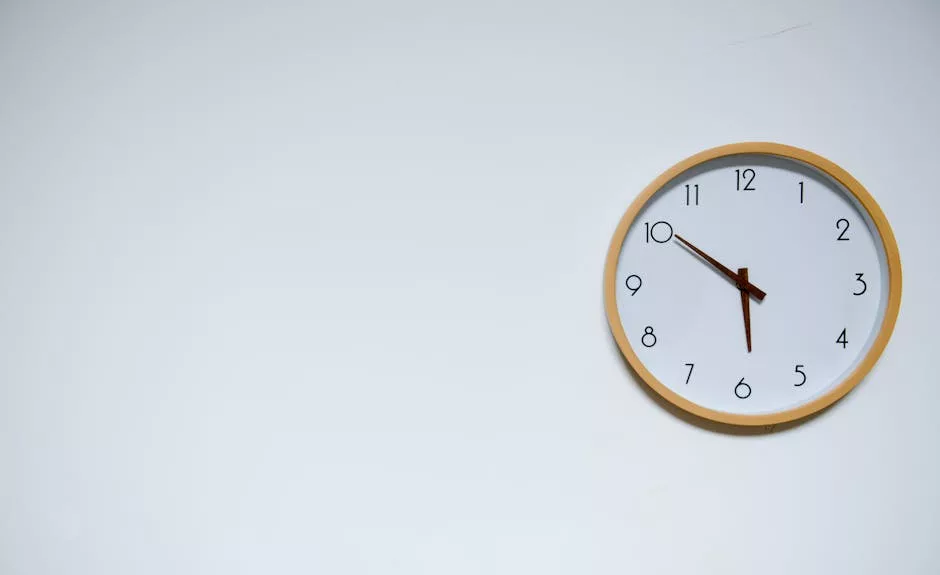Introduction
The Return of the Clock is a novel written by Agatha Christie, first published in 1929. The story revolves around a group of people who gather at a country house for a weekend party, only to find themselves caught up in a murder investigation when one of the guests is found dead. The clock of the title plays a crucial role in the plot, as it is discovered to have been tampered with in order to provide a false alibi for the killer. The novel is notable for its intricate plot and clever use of misdirection, as well as its memorable cast of characters.
The Significance of Time in The Return of the Clock

Time is a funny thing. It’s something we all experience, yet it’s intangible and elusive. We can’t hold it in our hands or see it with our eyes, but we know it’s there. And in the world of literature, time is often used as a powerful tool to create tension, build suspense, and drive the plot forward. One book that uses time in a particularly interesting way is The Return of the Clock by David Allen.
The Return of the Clock is a novel about a man named Jack who inherits an antique clock from his grandfather. The clock is said to have magical powers, and when Jack winds it up, he is transported back in time to the year 1926. There, he meets a woman named Rose and falls in love with her. But when he returns to the present day, he discovers that Rose has disappeared, and he must travel back in time again to find her.
One of the most significant ways that time is used in The Return of the Clock is to create a sense of urgency. Jack only has a limited amount of time in the past before he is transported back to the present day, and he must use that time wisely if he wants to find Rose. This creates a sense of tension and suspense that keeps the reader engaged and invested in the story.
Another way that time is used in the novel is to explore the theme of nostalgia. Jack is transported back to a time that he never experienced firsthand, and he is able to see the world through the eyes of someone who lived in a different era. This allows the reader to experience a sense of nostalgia for a time that they may not have lived through themselves.
But perhaps the most significant way that time is used in The Return of the Clock is to explore the idea of fate. Jack’s journey through time is not just a random occurrence; it is part of a larger plan that is unfolding before him. As he travels back and forth through time, he begins to realize that his actions have consequences, and that he has the power to shape his own destiny.
In many ways, The Return of the Clock is a meditation on the nature of time itself. It asks us to consider the ways in which time shapes our lives, and the ways in which we can shape time in return. It reminds us that time is not just a series of moments that pass us by, but a force that can be harnessed and used to create something meaningful.
So the next time you find yourself staring at a clock, remember that it’s not just a device for telling time. It’s a symbol of something much larger and more profound. It’s a reminder that time is always moving forward, and that we have the power to make the most of every moment. And who knows? Maybe if you wind it up just right, you’ll find yourself transported back in time to a world that’s waiting to be explored.
Exploring the Symbolism of the Clock in Literature
The clock has been a symbol in literature for centuries, representing the passage of time and the inevitability of mortality. From Shakespeare’s “All the world’s a stage” monologue to the White Rabbit in Lewis Carroll’s “Alice’s Adventures in Wonderland,” clocks have played a significant role in literature. But in recent years, the clock has made a comeback in popular culture, appearing in everything from movies to TV shows to music videos.
One of the most iconic uses of the clock in recent years is in the music video for Beyoncé’s hit song “Countdown.” In the video, Beyoncé wears a clock necklace and dances in front of a giant clock face, emphasizing the importance of time in our lives. The clock also appears in the lyrics of the song, with Beyoncé singing, “I’m trying to make the countdown, baby, trying to make the time.”
Another example of the clock’s resurgence in popular culture is in the TV show “Doctor Who.” The show’s main character, the Doctor, travels through time and space in a time machine called the TARDIS, which is disguised as a 1960s British police box. The TARDIS is powered by a “time rotor,” which looks like a giant clock face. The clock symbolizes the Doctor’s ability to manipulate time and his constant battle against the inevitability of time’s passage.
The clock has also made appearances in recent movies, such as “Inception” and “Interstellar.” In “Inception,” the characters use a spinning top as a way to determine whether they are in a dream or reality. The top is a symbol of time and the characters’ struggle to control it. In “Interstellar,” the characters travel through a wormhole in order to find a new home for humanity. The wormhole is represented by a clock face, emphasizing the importance of time in their mission.
But why has the clock made such a comeback in popular culture? Perhaps it is because we live in a world that is increasingly fast-paced and technology-driven. We are constantly connected to our devices and our schedules, and the clock serves as a reminder of the importance of taking a step back and appreciating the present moment.
The clock also serves as a symbol of mortality, reminding us that our time on this earth is limited. In literature, the clock often appears in stories about aging and death, such as Edgar Allan Poe’s “The Masque of the Red Death” and Virginia Woolf’s “Mrs. Dalloway.” These stories remind us that time is fleeting and that we must make the most of the time we have.
But the clock can also be a symbol of hope and renewal. In Charles Dickens’ “A Christmas Carol,” the clock strikes midnight, signaling the arrival of the Ghost of Christmas Yet to Come. The ghost shows Scrooge the future, giving him a chance to change his ways and make a better life for himself and those around him.
In conclusion, the clock has been a symbol in literature for centuries, representing the passage of time and the inevitability of mortality. In recent years, the clock has made a comeback in popular culture, appearing in everything from music videos to movies to TV shows. The clock serves as a reminder of the importance of taking a step back and appreciating the present moment, as well as the fleeting nature of time. But the clock can also be a symbol of hope and renewal, giving us a chance to change our ways and make a better life for ourselves and those around us. So the next time you see a clock, take a moment to reflect on its symbolism and what it means to you.
The Role of Time Travel in The Return of the Clock
Time travel has always been a fascinating concept in science fiction. From H.G. Wells’ “The Time Machine” to the “Back to the Future” trilogy, the idea of traveling through time has captured the imagination of audiences for decades. And now, with the return of the clock, time travel is once again at the forefront of our minds.
The clock, of course, is the titular object in “The Return of the Clock,” a new novel by acclaimed author J.K. Rowling. In the book, a group of intrepid adventurers use the clock to travel through time and prevent a catastrophic event from occurring. But what role does time travel actually play in the story?
At its core, “The Return of the Clock” is a classic adventure tale. The heroes must navigate treacherous terrain, outsmart their enemies, and overcome seemingly insurmountable obstacles in order to save the day. And time travel is the key to their success.
Throughout the book, the characters use the clock to travel back and forth through time, gathering information and resources that they need to complete their mission. They visit ancient civilizations, witness pivotal moments in history, and even interact with their own past selves. It’s a thrilling ride, full of twists and turns that keep the reader on the edge of their seat.
But time travel isn’t just a plot device in “The Return of the Clock.” It’s also a commentary on the nature of time itself. As the characters move through different eras, they begin to realize that time is not a fixed entity. It’s malleable, subject to change based on the actions of those who inhabit it.
This realization leads to some interesting philosophical questions. If time is not fixed, then what does that mean for our understanding of history? Can we truly know what happened in the past, or is our understanding of it always subject to revision? And if we can change the past, what does that mean for our future?
Of course, “The Return of the Clock” doesn’t provide easy answers to these questions. Instead, it invites the reader to ponder them for themselves, to consider the implications of time travel and what it might mean for our understanding of the world around us.
But for all its philosophical musings, “The Return of the Clock” is ultimately a fun, lighthearted romp through time and space. The characters are charming and relatable, the action is fast-paced and exciting, and the humor is spot-on. It’s the perfect book for anyone who loves a good adventure story, with a healthy dose of time travel thrown in for good measure.
So if you’re looking for a book that will transport you to another time and place, look no further than “The Return of the Clock.” It’s a thrilling ride that will leave you breathless and wanting more. And who knows? Maybe it will even inspire you to take a journey through time yourself. Just be sure to bring a clock with you.
Conclusion
Conclusion: The Return of the Clock is a short story that highlights the importance of time and the consequences of wasting it. The clock serves as a symbol of the fleeting nature of time and the need to make the most of every moment. The story also emphasizes the value of family and the power of forgiveness. Overall, The Return of the Clock is a thought-provoking tale that encourages readers to reflect on their own lives and how they choose to spend their time.



